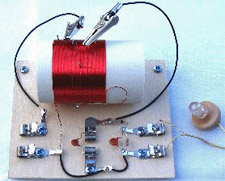It’s the time of year for saving money!
Do you remember crystal sets? No, not that kind of crystal. Not the ones claiming mystical healing powers, either, but an early kind of radio receiver that used a long wire antenna; had a “detector” made of a piece of galena crystal and a “cat’s whisker”; used a variable coil for tuning; needed no power source of any kind; and allowed you, through a pair of headphones (called “earphones” back then), to listen to local AM stations.
 A crystal set was, when I was in high school, the very first (non-kit) electronics project that I ever built. (If you’ve been around long enough, and took “electric shop,” it may have been yours, too.) Mine, which may or may not have been typical, just sorta worked and only picked up one or two of the strongest stations in the area, but it did give me my first exposure to headphones.
A crystal set was, when I was in high school, the very first (non-kit) electronics project that I ever built. (If you’ve been around long enough, and took “electric shop,” it may have been yours, too.) Mine, which may or may not have been typical, just sorta worked and only picked up one or two of the strongest stations in the area, but it did give me my first exposure to headphones.
Headphones are back now, stronger than ever, with a plethora of new and highly sophisticated equipment to drive them and, at the upper end, prices and performance to rival high-end speakers.
When the first television sets came out, they had tiny screens, not even twice the size of a standard business card. By 1950 or so, the technology was already improving, so when my parents got their first TV set, it was a lot bigger — an Emerson, as I recall, with a giant 10-inch screen. From there, TV manufacturers vied with each other to come out with, first, color TV (instead of the black-and-white that it had been from the beginning), and then screens that were ever-larger, stabilizing for a while (due to the manufacturing restrictions imposed by CRT technology) at little more than 27 inches, and then taking off again with the advent of flat-panel sets and video projectors to where a British firm named Titan announced in June of 2014 a new television set with a diagonal measurement of 370 inches — that’s 30.833 feet, or, if you prefer, just under 9.4 meters — and a price tag of US$1.7 million!
Even with all that, big screen TVs now seem — at least in the marketplace — to be passé, and many companies are currently offering apps that will allow you to watch your favorite TV shows on the tiny screen of your smartphone. Small screens are definitely back, and there can be no doubt that they’re the hot setup.
Also on the subject of telephones — “smart” and otherwise — consider this: From the late 1870s, the number of homes with telephone service steadily increased, until by the 1960s, nearly 60% of all American homes had telephone service available and, by 2000, American homes without telephones had dropped to only 2.4%. Just 10 years later, though, the use of cellphones had progressed to the point where more than one home in four had gone back to having no land line at all. By June of 2014, the number of cellphone-only American homes had increased to 40% — a total reversion in the percentage of available home land lines to the way it was in 1960.
Another turnaround story is the LP record (hee, hee hee!). After the first CDs were released in 1982, conventional wisdom said that the record player and the vinyl record were dead. CD manufacturers, pointing to the CD’s flat frequency response and greater signal-to-noise-ratio, touted “perfect sound forever” and consumers apparently believed them, which resulted over the next very few years in the near (but only near) extinction of analog recording. Then, even the general public seemed to have discovered what audiophiles had always known — that, for whatever reason, analog sounds better. Today, the LP record is the fastest-growing area of the industry, both for the music itsel, and the equipment to play it on, and another so-called “obsolete” technology is, once again, alive and well.
This “phoenix” theme, with something arising from its own ashes, has happened over and over again in hi-fi and consumer electronics. Not just with digital replacing analog only to see analog rise again, but also with solid-state replacing tubes and opening the way for a renaissance of tubed electronics. Or the constant parade of speakers going from cones to horns, to planars, to back to cones, to horns again, to… well, you get the picture. We’ve watched the same thing occur in any number of product areas.
I have no idea why this happens, but everything seems to be in some never-ending cycle of creation, change, obsolescence and restoration. Maybe it’s because having something drop out of sight for a while gives those who care about it time to take a fresh look and to create a fresh new approach and fresh new lines of products to embody it. Maybe it’s because marketers are always looking for some new way to reach potential customers, and nostalgia has proven customer appeal. Maybe it’s simply because, as with analog, some products or technologies that were declared obsolete shouldn’t have been. Whatever it is, things do seem to have a way to keep coming back again.
Maybe I should start working on a new crystal set.





